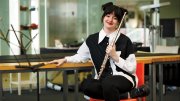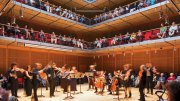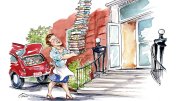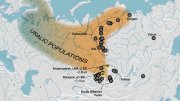During her junior year of college, Jessica Shand ’22 discovered topology—a branch of mathematics that studies how far shapes can stretch and morph before they lose their core properties. “I just thought it was so strange,” she says, “seeing these deformations of objects.” A double concentrator in math and music, Shand was familiar with the idea of math as “this very objective, ideal, transcendental thing.” Topology offered something more fluid: a field where continuity and transformation mattered more than exact measurements and calculations.
That interest in distortion mirrored her growing fascination with experimental music. Shand had first fallen in love with music during childhood ballet classes in Colorado Springs, where she was especially drawn to the flute parts in The Nutcracker. She asked her parents to start flute lessons—then couldn’t make a sound on the instrument for two months. (It’s harder to use breath efficiently at an elevation of 6,000 feet.) Once she succeeded, though, “music just kind of took over,” she recalls. She trained in classical flute, performed with youth orchestras in Colorado, and played at Carnegie Hall with the National Youth Orchestra. Eventually, she was accepted into Harvard and the New England Conservatory (NEC)’s joint A.B. and master of music degree program.
Once enrolled, Shand was exposed to new ways of making music. She worked with two of the world’s foremost flutists—music professor of the practice Claire Chase at Harvard and Paula Robison at the NEC—both of whom were “forging their own path” outside of the classical music world, experimenting with contemporary compositions. Shand also joined the Harvard College Opera, playing in the pit and eventually becoming the organization’s president. That provided the opportunity to adapt centuries-old works: “Even though it was classical music,” she says, “we were building our own structures around it and deciding how we wanted to do it.”
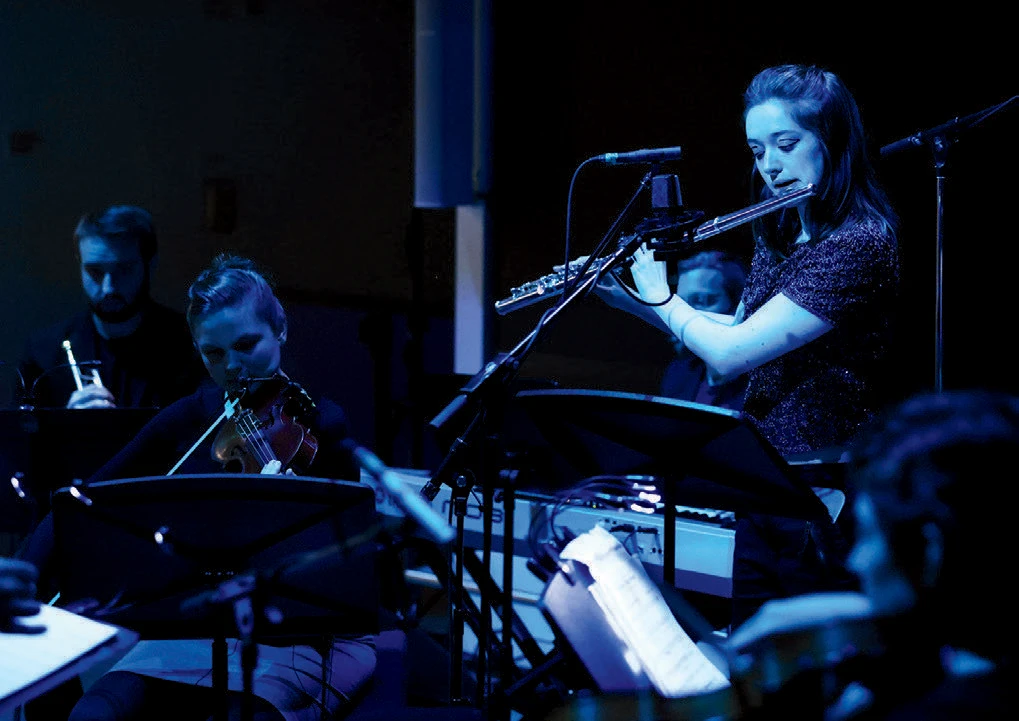
At the same time, the ideas she was learning in her classes at Harvard began to shape her approach to music. Shand wasn’t expecting to concentrate in math—in high school, she was more excited by the concrete applications of biology and chemistry. Studying proof-based mathematics at Harvard changed that. “I just became totally obsessed with that rigorous process of proving something,” she says, “starting from a definition and creating all of these structures around it.” She was fascinated by the abstractness of those definitions: A set is a collection of things. A triangle is a set of three points. She’d been layering assumptions onto these concepts, she realized, but their fundamental properties were far more basic. That simplicity was at the heart of topology, too—focusing on the core properties of shapes, rather than their exact measurements.
Shand decided to concentrate in both music and math, writing a senior thesis at the intersection of the two fields. For that project, she wrote five songs about topological graph theory, challenging the idea of math as objective and exploring “the social and political and economic contingencies of how math develops.”
One of her songs focused on the “seven bridges problem” from 1730s Königsberg, Prussia. The city, divided by the Pregel River, had seven bridges connecting two islands to the mainland. The puzzle: could you cross each bridge once, and only once? In 1736, mathematician Leonhard Euler proved it was impossible, laying the foundations for graph theory and topology.
To most mathematicians, that’s the end of the story. Shand, though, was interested in what happened next: during World War II, two of the bridges were destroyed in bombings. “While the problem originally didn’t have a solution,” Shand says, “now it does.” Another song delved into topology’s ability to bend, twist, and reshape forms, and asked, “What if we could do that in our everyday lives? What if we could see time as a shape—something we could bend and craft in a tactile way?”
After her senior year at Harvard, Shand decided to forego the fifth year of study required to complete her degree at the NEC. Instead, she enrolled as a master’s student in media, arts, and sciences at MIT, studying the intersection of technology, computer science, math, and music. When she was awarded a Steve Jobs Archive fellowship to make an album, she decided to explore a question related to those she asked in topology: how much can sounds change before they cross a threshold from one category to another?
She experimented with fragments of flute sound, using them as raw materials to be molded and reshaped using editing software. In the first song of the album, entitled Transmutations, she started with “a tongue pizzicato,” a short, percussive sound that resonates in the instrument. Shand then applied various transformations: adjusting the equalizer to heighten the high frequencies, adding reverb to create a sense of space. With each iteration, the sound transforms into airy, metallic chirps.
As part of her research, Shand conducted behavioral studies with both humans and AI models to explore how they perceived the sounds. Listening to the album’s first song, “Study No. 1,” many human listeners heard a sound with a projectile quality—something like fireworks. Others heard a bird call. (This listener heard water drops echoing in a cave.)
She then provided AI models with both sound and text, asking them to determine the degree to which they associated the two, to see how they classified the sounds. For the AI, there was a hard line where a sound transformed from one category to another—from a tongue pizzicato to an explosion. “The machine would see absolutely no relationship until the very end,” Shand says. That wasn’t true for humans, she says, who “can track these things and start to hear those differences gradually.”
Shand’s interest in sound, perception, and technology continues to shape her work as a Ph.D. student in music and multimedia composition at Brown University. She’s producing her own projects, including the sound design for a friend’s short film, and remains interested in the contingencies that shape math and music. While each sound may have measurable properties—frequency, amplitude, duration—Shand finds those numbers meaningless without perception: “What I find really magical is the interaction between sound and a listener,” she says, “and how that can open up so many different possibilities and associations.”
